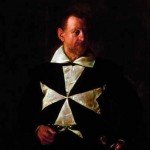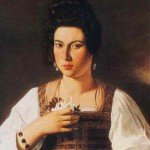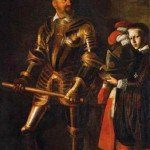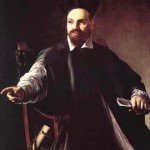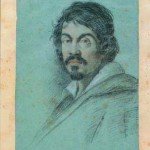Portraits and Portrayals
by John VARRIANO
Portraiture is perhaps the most natural challenge to the realist painter. Alone of the genres, it combines spirit with substance and focuses directly on living individuals. It would seem particularly natural that Caravaggio be moved to paint portraits since he was instinctively drawn to the human figure and the expressive psychology of the mind. Portraiture, moreover, was renowned among his predecessors and contemporaries in Lombardy and Rome. Painters in the north like Moroni, Lotto, and Cavagna, or Romans like Pulzone or Ottavio Leoni had fashioned highly realistic likenesses that Caravaggio could hardly have failed to notice (1). His principal patrons in Rome were enthusiastic collectors of portraits and their palaces were full of such pictures. Indeed, more than half of the 600 paintings in the Del Monte Collection were portraits (2).
Thus it is not surprising to find that Caravaggio was fairly active as a portraitist. His early biographers attest to the fact, at least for the early years of his career. Sandrart says “he painted many portraits,” Baglione marveled that he “was paid more for [them] than other painters obtained for their history pictures,” and Bellori commented that the artist “painted three heads a day” that he sold for very little (3). In addition, a number of his portraits are documented in early collections. Six of the 15 Caravaggios listed in the 1638 Giustiniani inventory were portraits, and others are cited in 17th-century inventories, guidebooks, and the like (4). Altogether, the existence of more than two dozen portraits by Caravaggio can be inferred from such sources. More than half of these portray prominent individuals: a painter, an architect, a poet, a jurist, several gentlemen, the Grandmaster of the Knights of Malta, a monsignor, two cardinals and a pope. The others are likenesses of people of lesser social or professional achievement: the architect’s wife, an innkeeper, two prostitutes and several figures whose station in life was unspecified.
Only three of the documented works can still be traced, and two of these – the portraits of the Grandmaster Wignacourt in the Louvre, and the Knight now identified as Antonio Martelli in Palazzo Pitti – are from his late years in Malta. The third portrait is an early work of a young woman identified in Vincenzo Giustiniani’s inventory as the “Courtesan called Phyllis” (5). In addition to these three documented works, some half a dozen other portraits have at various times been attributed to the artist. Among these are pictures like Monsignor Maffeo Barberini for which both the documentation and the visual evidence is weak, or the portrait of Cardinal Cesare Baronio for which there is no documentation but the visual evidence is strong (6). Intriguing though some of these proposals have been, no other portrait has won universal acceptance as an authentic Caravaggio.
Compared with other subjects painted by the artist, the portraits have had a disproportionately low rate of survival. Fewer than ten percent of the documented works can be traced, a remarkable fact given the importance of some of the sitters and the provenance of the pictures themselves. Where, for example, are the portraits of Cardinal Benedetto Giustiniani from the Giustiniani Collection or Melchiore and Virgilio Crescenzi from the Crescenzi Collection (7)?
The simplest explanation would be that some of the early attributions to Caravaggio were incorrect. Perhaps the uncertainty of knowing what a Caravaggio portrait should look like was as perplexing in the seventeenth century as it is today. Contemporary critics perhaps hinted why this was so when one noted wryly that Caravaggio had difficultly in “making a likeness” in his portraits and another found them “hard and dry” (8). Such weaknesses could explain the ongoing difficulty in identifying his activity in this genre, particularly when contemporary Roman portraitists like Scipione Pulzone and Ottavio Leoni were painting, in the words of the first critic, “ritratti somigliantissimi ,” portraits of great resemblance.
Years ago, Federico Zeri defined the achievement of Pulzone as a refined synthesis of the best of European sixteenth-century portraiture. This consisted of a precisely articulated physiognomy, a stately pose and setting, and an expression that captures “the qualities of a humanity that is alive and always changing” (9). An example of Pulzone’s mastery of the medium is his 1586 portraitof Cardinal Michele Bonelli now in the Fogg Art Museum, Cambridge. Although formally conventional, the sitter makes eye contact with the viewer and subtly conveys a sense of his shrewd and pensive personality. Hermann Voss was the first to point out Caravaggio’s dependence on this idiom, comparing the Courtesan Phyllis with Pulzone’s portraits of female patrons (10). Significantly perhaps, four of Pulzone’s portraits were in the collection of Cardinal del Monte where Caravaggio would have had easy access to them (11).
No less proximate if slightly moreproblematic are the portraits of Ottavio Leoni (12). Leoni devoted his life to the genre and was recognized in his time as the leading portraitist in Rome. In 1614 he was elected Principe of the Accademia di S. Luca, a sign of the esteem with which he was held by fellow artists. His patrons spanned a wide cross-section of society from high churchmen to “virtuous individuals of every profession,” while his chalk portrait of Caravaggio himself is universally recognized as the truest likeness of the artist to survive. Baglione praised Leoni as eccellentissimo and noted his skill in making portraits alla macchia, “so called because they are done after having seen the subject only once and rapidly” (13). There is no shortage of portrait drawings in which Leoni practiced the method (14). Like Caravaggio, he frequented the De1 Monte circle and was possibly the unnamed portraitist Del Monte praised very highly in a letter of 1599 (15).
Leoni’s portrait drawings–of which more than 700 can be accounted for—are relatively easy to identify, especially those made after 1615 when he began to date and number them in sequence. But his painted portraits, whose existence is recorded in several early sources, have proven to be more elusive. His signed canvas of Cardinal Scipione Borghese in Ajaccio is one of only four paintings to which his name remains securely attached (16). Baglione described Leoni’s painted portraitsas quanto il vivo (so alive) and similissimo (very accurate), but the naturalism of the Ajaccio picture is unremarkable, particularly if compared with Pulzone’s Cardinal Bonelli, painted some three decades earlier. Like Leoni’s other painted portraits, Scipione appears slightly stiff and psychically inactive, hardly the same ebullient figure captured by Bernini some years later (17). Pulzone’s likeness of Bonelli, by contrast, appears graceful and engaging. The integration of the inner and outer self in Leoni’s portrait is weak, the strict frontality of the cardinal’s face suggesting a disembodied head attached to a pre-existing torso.
The trajectory of Caravaggio’s own career as a portraitist intersects with pictures like these and one can only assume that his works in this genre were conceptually and stylistically unremarkable, even when seen in their own day. Most of the pictures cited in early sources are no longer tracable, and those that are appear indistinguishable from the work of lesser talents. It is hard to imagine documented paintings by Caravaggio of any other subject disappearing at such a prodigious rate.
Even the three portraits that are universally ascribed to Caravaggio – the Courtesan Phyllis, Alof de Wignacourt and Antonio Martelli (47,68,69) – disclose few signs of genius.
Although the original canvas has been destroyed and Phyllis is known only from a photograph, the image does little to belie Sandrart’s statement that Caravaggio’s portraits were “hard and dry.” The half-length format and frontal pose imply close spatial and physical proximity but she makes no eye contact with the painter/ viewer nor is there any suggestion of psychological, much less sexual, intimacy. The portrait of Martelli, painted towards the end of his life, is more successful.
Martelli was a member of a prominent Florentine family who resided on the island in 1607-08 and played a prominent role on the governing council of the Maltese Order. Martelli was reportedly a shrewd and politically astute individual who at the time was seventy four and had evidently lost some of his vigor. John Gash has described the picture with great sensitivity, finding shrewdness and cunning…[in the] infinitely suggestive portrayal. Indeed it is a striking aspect of the painting that it so strongly scrutinizes and evoke the minutiae of individual appearance while simultaneously projecting a symbolic persona. The transformation towards the latter is achieved by the figure’s far-away, introspective gaze, caught between illumination and shadow, the dominating presence of the light-catching cross on his tunic, and the way he emphatically holds both rosary beads and sword–emblematic of the poles of prayer and warfare between which an Hospitaller’s life oscillated…But when one focuses on the face it is pure existence that asserts itself–with all the complex and contradictory residues of a life lived and a personality at once forged and threatened (18).
It takes a sensitive eye to grasp the subtlety of the Martelli portrait. Structurally the picture is not particularly novel and expressively it is quite reserved. The quality of the work lies in the nuances of its psychology, not in its dramatic originality. In truth, Caravaggio still has not advanced the art of portraiture beyond the reach of Titian or Tintoretto. And only now, near the end of his career, did he succeed in endowing a portrait with the humanity that was the hallmark of his best narrative paintings.
Endnotes
1 See, for example, the portraits included among the “Precursors” and “Contemporaries” in the exhibition catalogue The Age of Caravaggio, New York, 1985, pp. 49-87, 80-195, and more recently, Il ritratto in Lombardia da Moroni a Ceruti, ed. by A. Morandotti, Varese, 2002, p. 222.
2 C. Gilbert, Caravaggio and his Two Cardinals, University Park, 1995, p. 114 underscores the point that of the thirteen thematic categories in Del Monte’s collection, “portraits overwhelmingly suggest that there are better grounds for determining Del Monte’s ways of relating to art than have been used.” Del Monte’s collection was first published by C. L. Frommel, “Caravaggios Frühwerk und der Kardinal Francesco Maria del Monte,” Storia dell’Arte 9-10 (1971) pp. 5-52.
3 Hibbard, Caravaggio, p. 356 and 376. Bellori’s comment was made in a marginal note in his copy of Baglione but his own biography of Caravaggio is particularly helpful for in it he names a few of the sitters.
4 See J. T. Spike, Caravaggio, New York and London, 2001, CD-ROM “Catalogue of Paintings” for the most recent and complete survey of the documented, lost, and attributed portraits. Searching this catalogue alphabetically allows one to collect all the portrait entries together. The Giustiniani inventory was first published by L. Salerno, “The Picture Gallery of Vincenzo Giustiniani,” The Burlington Magazine CII (1960) pp. 21-27, 93-104, 135-48.
5 This picture, one of two courtesans listed in Giustiniani’s inventory (the other identified simply as “A Famous Courtesan”) was tragically lost in World War II.
6 Spike, Caravaggio, cats. 36 and 31.
7 Spike, Caravaggio, cats. L. 90 and L.81 and L. 111.
8 The first comment was from Giulio Mancini’s Considerazioni sulla pittura, reprinted, Rome, 1956, vol. 1, p. 136; the second from Joachim von Sandrart’s Academie, translated by Hibbard, Caravaggio, p. 376.
9 F. Zeri, Pittura e controriforma, first ed. 1957, 3rd edition, Vicenza, 1997, pp. 12-13.
10 H. Voss, “Caravaggios Frühzeit zur Kritik seiner Werke und seiner Entwicklung,” Jahrbuch der Preussichen Kunstsammlungen XLIV (1923) p. 81; cited by A. Zuccari in The Age of Caravaggio, p. 172.
11 One of the four was a portrait of Del Monte himself (Frommel, “Caravaggios Frühwerk,” p. 32).
12 See H-W. Kruft, “Ottavio Leoni als Porträtmaler,” Storia dell’arte 71-73 (1991) pp. 183-90; C. R. Robbin, “Ottavio Leoni and Early Baroque Portraiture in Rome,” Ph.D. dissertation, University of California, Santa Barbara, 1991; idem, “Ottavio Leoni as a painter,” Storia dell’arte 99 (2000) pp. 84-93; F. Solinas, “La Signora degli Scorpioni. Un inedito di Ottavio Leoni (1578-1630) e qualche ritratto romano del tempo di Caravaggio,” in Caravaggio nel IV centenario della Cappella Contarelli, Atti del Convegno, ed. by Caterina Volpi, Rome, 2002, pp. 243-65; and J. T. Spike, “Ottavio Leoni’s Portraits ‘alla machia,’” in Baroque Portraiture in Italy: Works from North American Collections, pp. 12-19.
13 G. Baglione, Le vite de’ pittori, scultori et architetti, reprinted 1975, p. 144.
14 According to C. R. Robbin, “Scipione Borghese’s acquisition of paintings and drawings by Ottavio Leoni,” The Burlington Magazine CXXXVIII (1996) p. 457, Leoni is known to have made at least 708 drawings.
15 The letter Del Monte wrote to Ferdinando de’Medici describes a painter “che è un giovane mio allievo quale lavora meglio, più diligente, et più somigliante senza comparatione di quello poveretto di Scipione [Pulzone].” Transcribed in Z. Wazbinski, Il cardinale Francesco Maria del Monte 1549-1626, Florence, 1994, vol. II, p. 518.
16 H-W. Kruft, “Ottavio Leoni,” fig. 5.
17 Bernini’s two busts of Cardinal Scipione Borghese are still in the Villa Borghese, Rome; See R. Wittkower, Gianlorenzo Bernini, London, 1966, cat. 31.
18 Gash, “The identity,” p. 159.
About the Author
John Varriano has a special interest in the art and architecture of 17th-century Rome and has published more than three dozen specialized studies in his field. His most recent book is Caravaggio and the Art of Realism. Active in the Mount Holyoke College European Studies Program, Varriano has also served four terms as chair of the College’s Department of Art. He held an endowed chair named after the first woman in America to spend her junior year abroad, and he strongly encouraged his current students to do the same. Varriano taught European art from the 15th through the 18th centuries. His intermediate-level courses included Italian Renaissance Art, Southern Baroque Art and Northern Baroque Art. Recent seminars have included The Sacred and the Profane, The History of the City of Rome, Palladio and Palladianism, Caravaggio and His Followers and Old Master Drawings.

